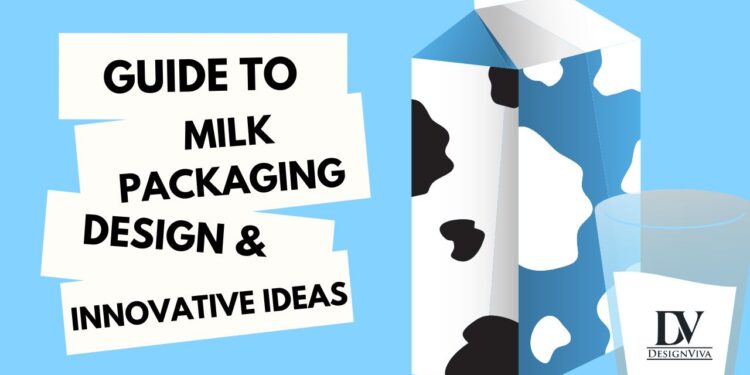The packaging of any product has a direct impact on consumers’ purchase decisions. This is especially true when it comes to milk packaging design. How the product is presented to customers can determine how successful it will be in the market.
In this article, we will explore some of the basic aspects of milk packaging design and its impact on consumers. We’ll also look at some of the latest trends in milk packaging and ideas for innovative designs that could help you stand out from the competition. Finally, we’ll discuss how these designs can lead to an increase in sales and customer engagement.
How Different Types of Milk Packaging Affect Brand Perception
Nowadays, consumers are becoming more conscious of their purchasing decisions and the effects of their actions on the environment. Therefore, sustainable and eco-friendly packaging for milk is becoming increasingly popular.
Consumers are showing a preference for more sustainable packaging that uses fewer resources, has less environmental impact, and is better for animal welfare.
Packaging plays an important role in shaping consumer perception of a brand and influencing their purchase decisions. This means that different types of milk packaging have a direct impact on how customers view the product and whether they will buy it or not. In this article, we will explore how different types of milk packaging, such as aseptic packaging, plastic-free packaging, and environmentally friendly options affect customer perception of brands that sell milk products.
Here are some ways in which different types of milk packaging can affect brand perception:
Cartons
Milk packaged in cartons, which are typically made of paperboard or paper-based materials, can convey an eco-friendly and sustainable image. Cartons are often associated with natural and organic products, and consumers may perceive milk in cartons as being more wholesome, pure, and environmentally friendly. Brands that use carton packaging may be seen as socially responsible and environmentally conscious, which can positively influence brand perception among environmentally-conscious consumers.
Plastic bottles
Milk packaged in plastic bottles can convey convenience and durability. Plastic bottles are typically lightweight, easy to handle, and can be resealable, which makes them convenient for consumers to use and store. Brands that use plastic bottles may be perceived as modern, practical, and suitable for on-the-go consumption. However, plastic packaging can also raise concerns about environmental sustainability and plastic pollution, which can negatively impact brand perception among environmentally-conscious consumers.
Glass bottles
Milk packaged in glass bottles can convey a premium and nostalgic image. Glass bottles are often associated with high-quality and artisanal products, and consumers may perceive milk in glass bottles as being more natural, pure, and traditional. Glass bottles can also be recycled and are considered more environmentally friendly compared to plastic bottles. Brands that use glass bottles may be seen as premium, authentic, and eco-friendly, which can positively influence brand perception among consumers who value sustainability and premium products.
Tetra Pak
Tetra Pak is a brand of packaging material that uses laminated layers of paperboard to create lightweight, airtight, and shelf-stable cartons. Tetra Pak cartons are often used for long-life milk that does not require refrigeration. Tetra Pak cartons can convey convenience, sustainability, and innovation. Brands that use Tetra Pak packaging may be perceived as modern, innovative, and environmentally friendly, as Tetra Pak cartons are often associated with extended shelf life, reduced food waste, and recyclability.
Pouches
Milk packaged in pouches, which are made of flexible plastic materials, can convey a modern and innovative image. Pouches are lightweight, flexible, and often resealable, making them convenient for on-the-go consumption. Pouches can also have unique shapes and designs that can help brands stand out on store shelves. Brands that use pouches may be perceived as trendy, innovative, and suitable for modern lifestyles. However, pouches may also raise concerns about plastic waste and recycling, which can affect brand perception among environmentally-conscious consumers.
In summary, different types of milk packaging can evoke different perceptions and associations among consumers. Factors such as sustainability, convenience, premium quality, innovation, and authenticity can all be influenced by the type of milk packaging used by a brand and can impact brand perception accordingly. It is essential for milk brands to carefully consider their packaging choices and align them with their brand values and target audience preferences to create a positive brand perception.
Highlighting Examples of Effective & Uniquely Designed Milk Packages.
Here are some examples of effective and uniquely designed milk packages that have captured the attention and stood out in the market:
Happy Cow Farms Milk Bottle
Happy Cow Farms, a fictional brand, used a unique bottle design that resembles a happy cow with its ears and horns forming the handles. The bottle is made of transparent plastic, allowing consumers to see the milk inside, and the playful design immediately grabs attention and creates a memorable image.
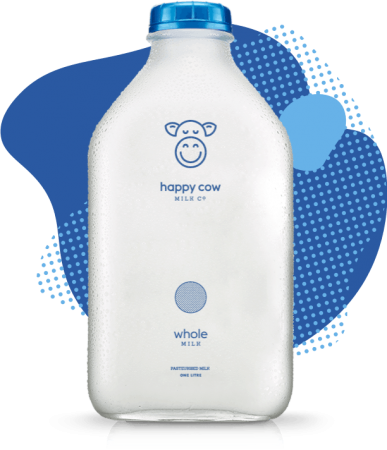
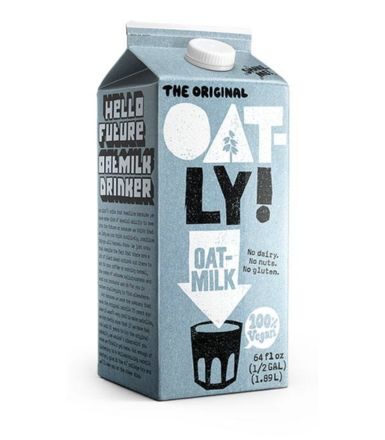
Oatly Oat Milk Carton
Oatly, a popular plant-based milk brand, uses a minimalist and clean design for their oat milk cartons. The cartons feature a simple and bold typographic logo, with playful and quirky messages that convey the brand’s personality and values. The use of bold black and white colors, along with clever messaging, creates a visually striking and memorable design.
Moo Milk Pouch
Moo Milk, a fictional brand, uses a pouch design for their milk packaging that resembles a cow’s udder. The pouch is made of flexible plastic, mimicking the texture and shape of a cow’s udder, and has a unique spout for easy pouring. The playful and creative design immediately catches attention and creates a memorable association with the brand’s name and image.
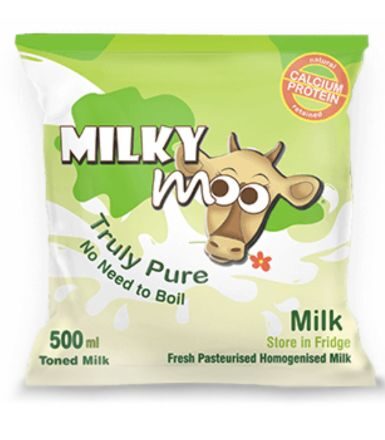
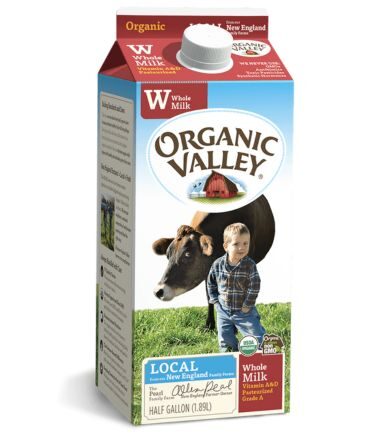
Organic Valley Milk Carton
Organic Valley, an organic milk brand, uses a nature-inspired design for their milk cartons. The cartons feature illustrations of cows grazing in green pastures, surrounded by trees and flowers, creating a wholesome and eco-friendly image. The use of earthy colors and the depiction of a farm scene evoke a sense of freshness, purity, and sustainability.
Nestlé Nesquik Chocolate Milk Bottle
Nestlé Nesquik, a popular chocolate milk brand, uses a unique bottle design that features a playful shape of a cow on the top. The bottle is made of clear plastic, allowing consumers to see the chocolate milk inside, and the cow-shaped cap adds a fun and whimsical touch to the packaging, making it stand out on the shelves.
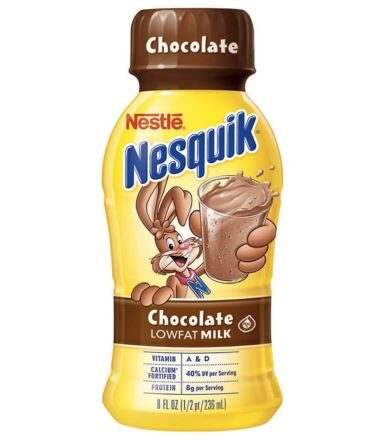
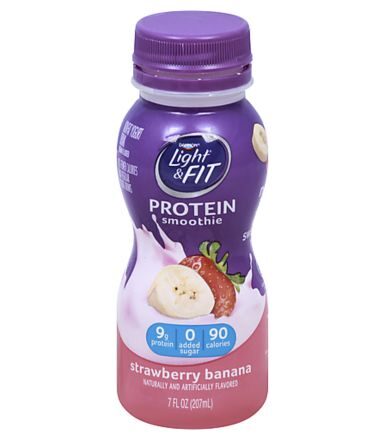
Danone Light & Free Yogurt Drink Bottle
Danone Light & Free, a yogurt drink brand, uses a sleek and modern bottle design that features a slim and elongated shape with a curvy silhouette. The bottle has a minimalist and clean design with subtle use of pastel colors, creating an elegant and sophisticated look that appeals to health-conscious consumers.
These examples showcase how creative and unique milk packaging designs can capture attention, convey brand personality and values, and create a memorable impression on consumers. Brands can draw inspiration from these examples to develop their own eye-catching milk packaging designs that stand out in the market.
Analyzing Market Trends in Milk Packaging & Identifying Opportunities for Brands
Milk packaging is an important component of the dairy industry and it plays a vital role in the successful sales of milk products. It is essential for brands to be aware of current market trends in order to stay ahead of their competitors. With modern milk carton design becoming increasingly popular, it is essential for brands to pay attention to this trend and identify opportunities that can help them stand out from the competition.
Analyzing market trends in milk packaging can help brands identify opportunities for custom-designed cardboard boxes that can be used for dairy products. This can help brands create a premium branded milk carton design that will make them stand out from others on the market. By understanding current trends and identifying new opportunities, brands can ensure they are meeting customer needs and staying ahead of the competition.
Here are some key market trends in milk packaging and potential opportunities for brands:
Sustainable Packaging
Sustainability is a significant trend in the packaging industry, and consumers increasingly prefer packaging that is eco-friendly, recyclable and reduces plastic waste. Brands can explore opportunities to use packaging materials such as cartons made from renewable resources, biodegradable or compostable materials, or recycled plastics. Highlighting the sustainability aspect of the packaging can attract environmentally-conscious consumers and positively impact brand perception.
Convenience & Portability
Consumers today seek convenience and portability in their food and beverage choices, including milk. Packaging that is lightweight, resealable, and suitable for on-the-go consumption can be appealing to busy consumers. Brands can consider packaging options such as plastic bottles, pouches, or Tetra Pak cartons that offer convenience and portability features to cater to consumer demands for ease of use and portability.
Premium Packaging
Premium packaging can create a perception of high quality and exclusivity, which may attract discerning consumers. Brands can consider packaging options such as glass bottles or unique and aesthetically pleasing designs to create a premium image. Premium packaging can be especially relevant for specialty or artisanal milk products, where packaging can play a crucial role in positioning the product as high-end and unique.
Innovation & Differentiation
Packaging can be a way for brands to differentiate themselves in a crowded market. Brands can explore innovative packaging solutions, such as smart packaging with interactive features, augmented reality, or unique shapes and sizes that stand out on store shelves. Creative and innovative packaging can capture consumer attention and create a memorable brand impression.
Health & Safety
With increasing consumer focus on health and safety, milk brands can consider packaging options that ensure product freshness, purity, and safety. Tamper-evident seals, air-tight packaging, or UV-protective materials can convey a sense of product integrity and safety to consumers, which can positively impact brand perception.
Customization & Personalization
Customization and personalization are emerging trends in packaging, allowing brands to create a unique and personalized experience for consumers. Brands can consider options such as customizable labels, packaging with consumers’ names or photos, or packaging that can be repurposed for other uses. Customization and personalization can create a sense of connection and engagement with consumers, fostering brand loyalty.
Digital Integration
In today’s digital era, packaging can be integrated with digital technologies to enhance consumer engagement and provide additional value. Brands can consider incorporating QR codes, NFC tags, or augmented reality features on packaging to provide information, promotions, or interactive experiences for consumers. Digital integration in packaging can create an immersive and interactive brand experience, which can be appealing to tech-savvy consumers.
In conclusion, staying informed about market trends in milk packaging and identifying opportunities to align with consumer preferences can be critical for brands to remain competitive and meet evolving consumer needs. Sustainability, convenience, premium packaging, innovation, health & safety, customization, and digital integration are some of the key trends that brands can consider when evaluating milk packaging options and creating a positive brand perception in the market.
Revealing Creative Ideas for Developing Eye-catching Milk Packaging Designs
Milk packaging design is an important part of the branding and marketing of milk products. Eye-catching milk packaging designs help to draw the customers’ attention, increase sales, and create a unique point of difference in the market. In this article, we will discuss creative ideas that can help you develop eye-catching milk packaging designs for your products. We will discuss various creative milking solutions, different creative milking designs, and creative milking marketing campaigns that can be used to create a unique identity for your product. With these ideas, you can create an effective and well-designed milk packaging design that will make your product stand out from the competition and draw more customers to it.
Here are some creative ideas that can help brands create visually appealing and attention-grabbing milk packaging designs:
Bold and Vibrant Colors
Using bold and vibrant colors can make milk packaging stand out on the shelves. Brands can experiment with bright colors that evoke a sense of freshness and vitality, and that also align with their brand identity. For example, using hues of green, blue, or yellow can create a visually appealing and eye-catching design that catches the consumer’s attention.
Unique Shapes and Structures
Playing with unconventional shapes and structures can make milk packaging stand out from traditional designs. Brands can consider using unique bottle shapes, carton structures, or pouch designs that are visually appealing and memorable. For example, a milk bottle shaped like a cow, or a carton with an innovative foldable design can instantly capture consumer attention.
Minimalist and Clean Designs
Simplicity can also be eye-catching. Minimalist and clean designs with a focus on simple typography, sleek lines, and white space can create an elegant and modern look. Brands can use minimalistic design elements that convey a sense of purity and simplicity, which can be appealing to consumers seeking a clean and contemporary aesthetic.
Playful and Whimsical Illustrations
Incorporating playful and whimsical illustrations can add a touch of creativity and uniqueness to milk packaging. Brands can consider using illustrations that depict farm scenes, animals, or nature-inspired motifs that create a sense of joy and evoke positive emotions. Playful illustrations can make the packaging visually engaging and memorable.
Texture and Tactile Elements
Adding texture or tactile elements to milk packaging can create a multi-sensory experience for consumers. Brands can consider using embossing, debossing, or textured materials that add depth and dimension to the packaging. Tactile elements can create a unique and memorable touch and feel-experience that sets the packaging apart.
Storytelling and Brand Narrative
Incorporating storytelling and brand narrative elements into milk packaging can create an emotional connection with consumers. Brands can use packaging as a canvas to tell their brand story, share their values, or highlight the origins of the milk. Including compelling visuals or text that communicates the brand’s story can make the packaging more interesting and memorable.
Sustainable and Eco-friendly Materials
Packaging made from sustainable and eco-friendly materials can also be visually appealing and attract environmentally-conscious consumers. Brands can consider using materials such as recyclable paper, biodegradable or compostable plastics, or plant-based materials that convey a sense of eco-friendliness and sustainability. Highlighting the use of sustainable materials in the packaging design can be an attractive selling point for environmentally-conscious consumers.
Remember, the key is to create a packaging design that is not only visually appealing but also aligns with the brand identity and resonates with the target consumers. Incorporating creativity, innovation, and unique elements in milk packaging designs can help brands create eye-catching designs that stand out in the market and create a memorable impression on consumers.

